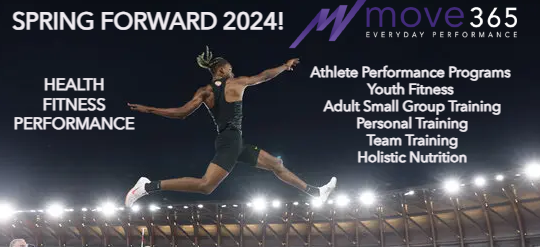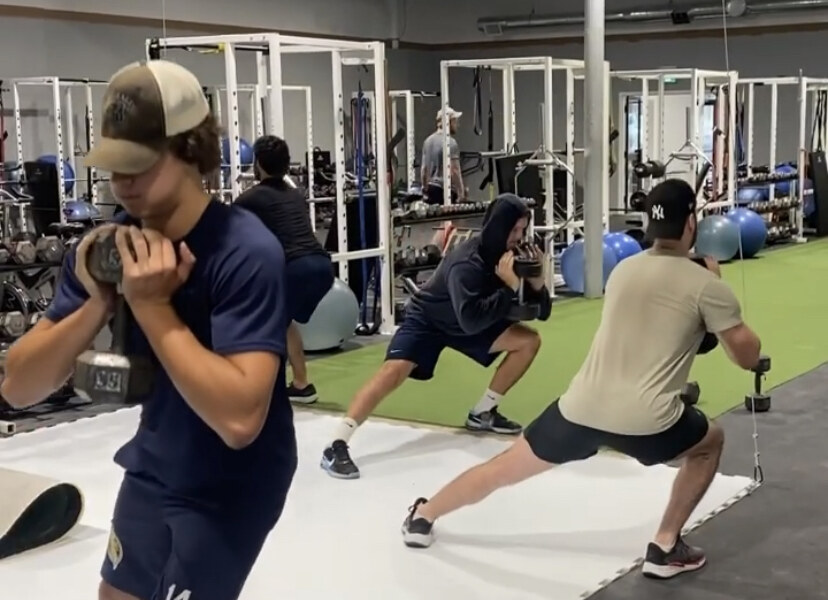Spring Small Group Program April 1-June 30 (13 Weeks)
Health. Fitness. Performance.
“We should not judge people by their peak of excellence; but by the distance they have traveled from the point where they started.”
– Henry Ward Beecher–
Move365 Spring Small Group Programs will help you move better, move faster and move stronger, to excel in spring & summer sports and activities, and prepare for fall & winter season. Most importantly, we will focus on building age and skill specific foundations for the years ahead.
Sessions are coached in small groups, with attention to individual needs. Each person has their own space to move, lift and learn as we aspire to inspire everyone to a lifelong appreciation for health and fitness and help them move better and perform better in their sport and/or in their daily life along the way.
All in-person sessions will take place inside our Move365 training centre, located at 104-114 Dundas Street East. The training area is complete with a turf area for movement and speed development, sled work and an active sports area with synthetic ice and a netted area for shooting pucks and LAX balls, hitting baseballs, golf balls etc.
2024 SPRING YOUTH PROGRAMS April 1 – June 30 (13 Weeks)
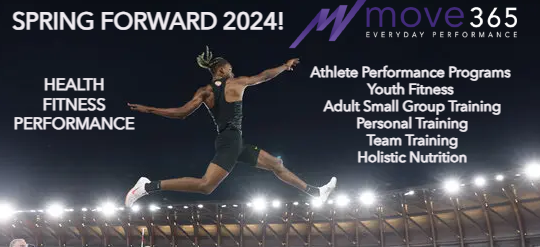
FUNDAMENTAL ATHLETIC DEVEOPMENT – ages 9-11
- Tuesdays and\or Thursdays 4-5pm
- Price – 2+x per week = $15/session ; 1x per week $20/session + HST
- Packages sold in sessions packages/seasonal blocks
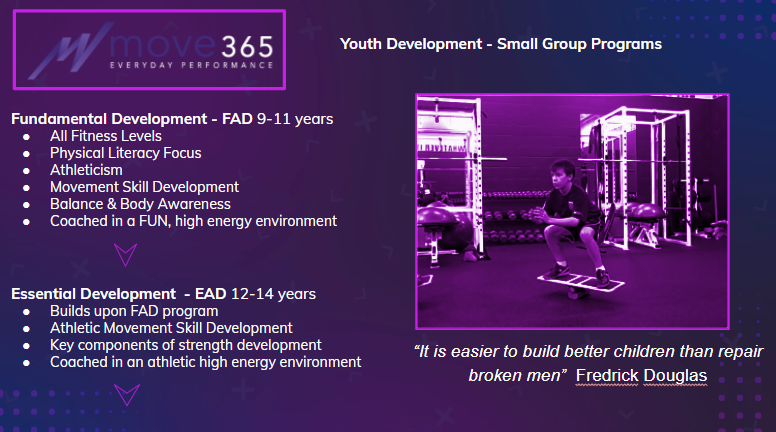
Kids are not just little adults, the need to learn to move properly and have some fun along the way. This is the beginning of athletic development. The FUNDAMENTAL Program focuses on developing overall athleticism, body awareness, the important elements of physical literacy, fitness & performance. We will put the FUN in Fundamental! Kids will learn how to stop & land, change direction efficiently, and build a foundation of coordination and movement efficiency through games, drills and progressions designed to build specific movement skills, help them move better, react quicker, be faster and have fun!
ESSENTIAL ATHLETIC DEVEOPMENT – ages 12-14
- Tuesdays, Thursdays 5-6; Saturdays 12-1pm
- Price – 1x/week $20\session 2x $18/ 3x $45/week or package of 20 or more $15/session + HST
- Packages sold in seasonal blocks
The ESSENTIAL Athletic Development Program is the perfect opportunity for young teens to learn to train properly in order to develop all aspects of fitness, athleticism, strength, & athletic performance. The program will challenge movement skill development, and teach the key components of strength (squat, lunge, hinge, push, pull etc). EAD is also a perfect progression program to bridge the gap between the Fundamental age and the Advanced Athlete Development Program.
Please CONTACT US us to register or for more details
ADAVANCED ATHLETE DEVELOPMENT – High School (ages 14+)
- Mon/Wed/Fri 3:45-5 and 5-6:15
- Saturdays 10:30-11:45am
- Price – 1-2x/week $25/; 3-4x/week (Unlimited) $60/week + HST
- Packages sold in seasonal blocks
Please CONTACT US us to register or for more details
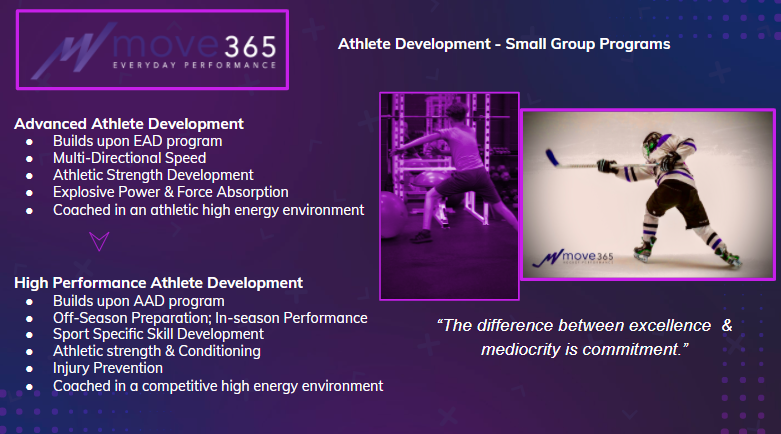
Athletes need to continuously work to build the qualities that will help them excel in sport & maximize their training knowledge & training capacity at this crucial development age. Anyone who just wants to learn to move better, get stronger, and improve their health and fitness can also benefit in this program. The ADVANCED program is designed for athletes aged 14+ who are ready to expand their development, to build more athletic strength, explosive power, athletic movement skills, linear & multi directional speed, & more. This 75min program is designed to help each athlete elevate their training and their performance to the next level
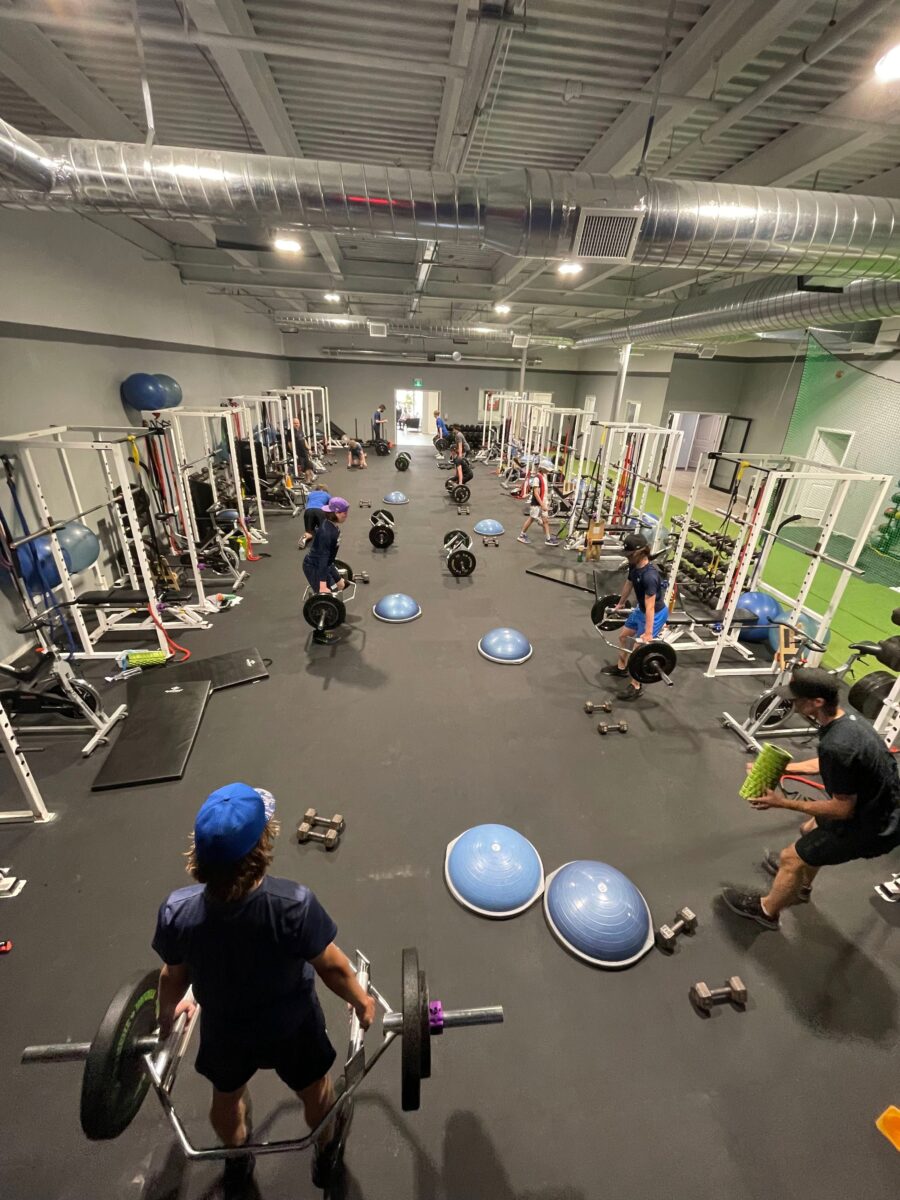

Also available:
- High Performance Athlete Training (and Custom Small Groups)
- High Performance Team Training (and Custom Small Groups)
- Youth Personal Training
- Holistic Nutrition
- Injury Rehab, Athletic Therapy, Physiotherapy, and Massage Therapy
- New to Move365? We make it easy to start moving everyday with your First Week FREE!
- Get Your Family moving with a 10% Discount for 2 or more
Please CONTACT US for more details on programs, schedules or to register.
Anyone can train athletes and make them tired but it takes a coach to teach them, to motivate them, to get them to buy-in to the process and to make them better.
Peak for Progress NOT Maintenance
The in-season training mindset for hockey is often focused too much on maintenance and not enough on performance.
It was not that long ago that players did not even START training until they arrived at Training Camp; hence the name. In the last 10 years, off-season strength & conditioning has evolved and progressed to focus on maximizing the size, strength, speed and skill of athletes during the summer to be more fully prepared to start the season, but there is still another missing link that must be be developed.
Players want to be at their best when the competitive season hits, not in September. No matter how hard, or how smart or how effectively the athlete works in the off-season, players who do not participate in a proper in-season conditioning program are often detrained by playoff time and, at the highest risk for injury when they need to be the most prepared.
The current in-season programming mentality still focuses too much on maintenance and not enough on progression. It sells short the potential of the players along with the knowledge of a skilled strength and conditioning coach and it’s becomes a roll of the dice to the athlete to expect that they can avoid injury and perform at their best when the playoffs arrive. The goal should be to increase strength, maximize mobility and shift specific conditioning, encourage proper nutrition, sleep, rest and recovery, and to inspire them to stay focused on getting better. Most importantly, we must ensure that off-ice training and development has purpose and does not just waste their time and energy.

Move Better – Play Better!
Quality movement is the key to athletic excellence. It is also the key to optimal health, fitness and performance. Developing hockey players is a long term process that takes planning, patience and purposeful programming (on and off the ice) to initiate and enhance motor learning (skills and movement patterns), physical adaptations (strength, power, conditioning), and tactical knowledge (knowing where to be in space, team tactics, hockey IQ, etc.).
Hockey players in Canada have the best opportunity for seasonal development. The off-season arrives as spring merges with summer just as school ends creating the perfect combination of time and opportunity for physical and mental preparation for the start of the season. Strength and conditioning coaches are blessed with the perfect laboratory of training as we have a chance to create programs and put together drills that take full advantage. Athletes generally have 10-12+ weeks to commit fully on setting and accomplishing the goals they have for the season and put the time and energy they need into achieving them. Unfortunately, many players and teams do not carry the momentum and development of the summer into the season. When this happens much of the hard earned summer gains can quickly begin to disappear.
Hockey demands a high level of mental and physical focus for optimal performance. The season is long, practice time is often devoted to technical development, tactical execution and positional/strategic rehearsal with the odd “bag-skate” mixed in, often to the detriment of conditioning & skating technique rather than improving it. How can players keep getting better, stay strong and continue to maximize their in-game performance as the season progresses?
The game of hockey, while intense and physical, does not create adequate opportunity for strength and conditioning development. The opposite usually results. A well designed training schedule can stop the potential decline and should continue to allow the athlete to improve. It should develop athletic foundations, increase performance, improve mobility/stability, and help maximize recovery & regeneration. As the season starts the timing is perfect to re-set the body, re-focus on new goals and re-boot the training program within the in-season schedule. This means working around practices and competitions, scheduling on and off-ice development and considering recovery and adaptation needs such as nutrition, hydration, rest and sleep. From a programming perspective, the program should build intensity and complexity back up through the fall, then re-set again in December in order to peak for the post-season and playoffs in Feb/March.
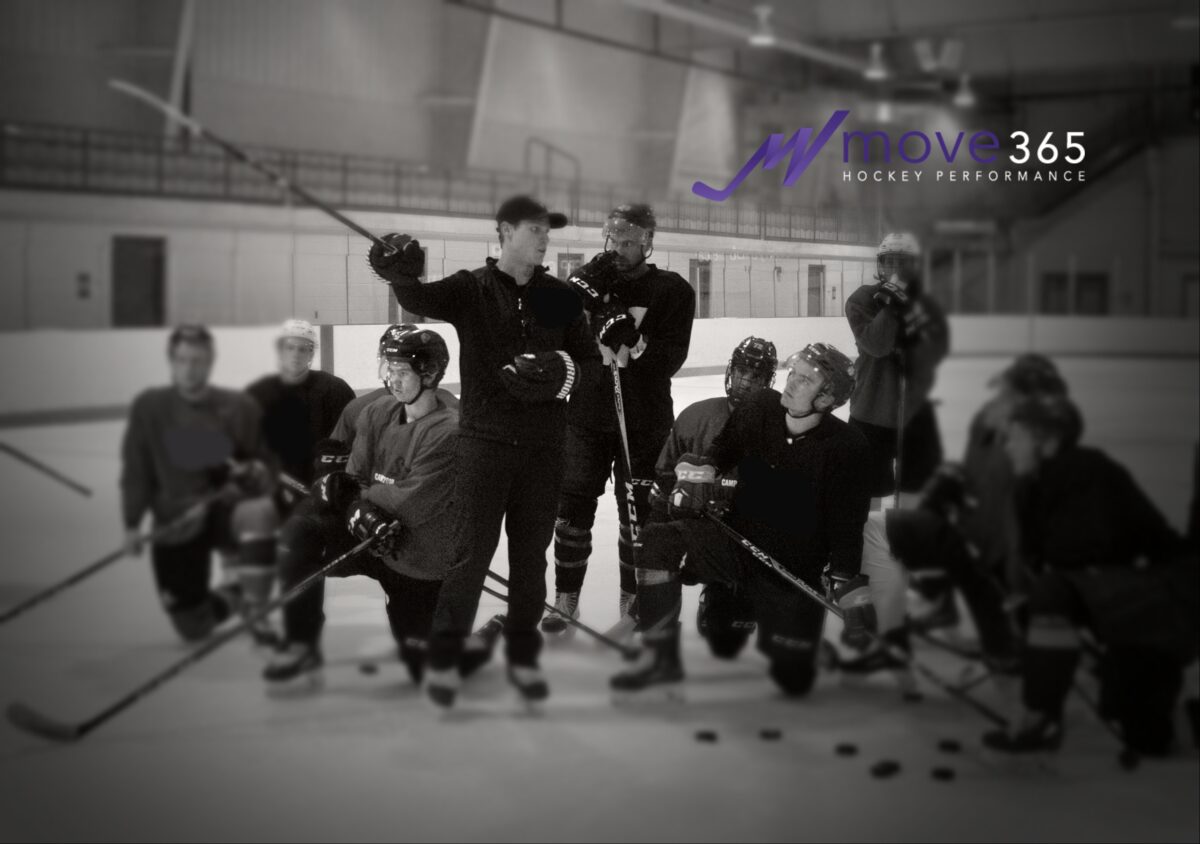
Learn it. Earn it. Own it.
When it comes to skill development we learn in a relatively specific process. The level of learning, depth of learning and ultimate potential of skill development comes down to how good the coach/teacher is, how much deliberate/purposeful practice the athlete can put in along the way and how successful they are at making a new skill their own. This is the same for sports skills as it is for learning new drills, movement patterns and exercises in the gym. Quality learning opportunities, commitment and effort can go a long way in setting athletes up for success, while genetics and innate ability play a significant role in how fast this can happen and how high the ceiling may be for development, so choose your parents wisely!
Skill Acquisition
To build competence in a new skill, there are 3 main stages for learning new skills and motor patterns:
LEARN IT! This is known as the Cognitive Stage. Everything during this stage takes more time and focus and ideally, a good coach/teacher to guide you through as efficiently as possible. We fail often and begin to build patterns of success and/or bad habits along the way. It can be slow, frustrating and even embarrassing but it is also often the most rewarding. The good news is kids learn fast (sorry parents) especially at younger ages so when it comes to developing skills, languages, music etc. the sooner the better.
EARN IT! This is the Associative Stage. Now we have the basic skill and need to practice, practice, practice. This practice however needs to be purposeful and ideally with good feedback and positive reinforcement in order for it to become a more repeatable motor pattern. Practice does not always make perfect, perfect practice makes perfect. This is where the most improvement and development takes place and where we see limits and potential in certain skills. Some people are not built to be gymnasts.
OWN IT! This is the Autonomous (or Automatic) Stage. You got this! The skill is yours. You don’t need to think about it, you just feel it. Now it is time to make it better which means pushing your skill to a new level and moving back into the cognitive or associative stage in order to progress to new levels of success. Once you get to this level of skill acquisition, that skill is yours.
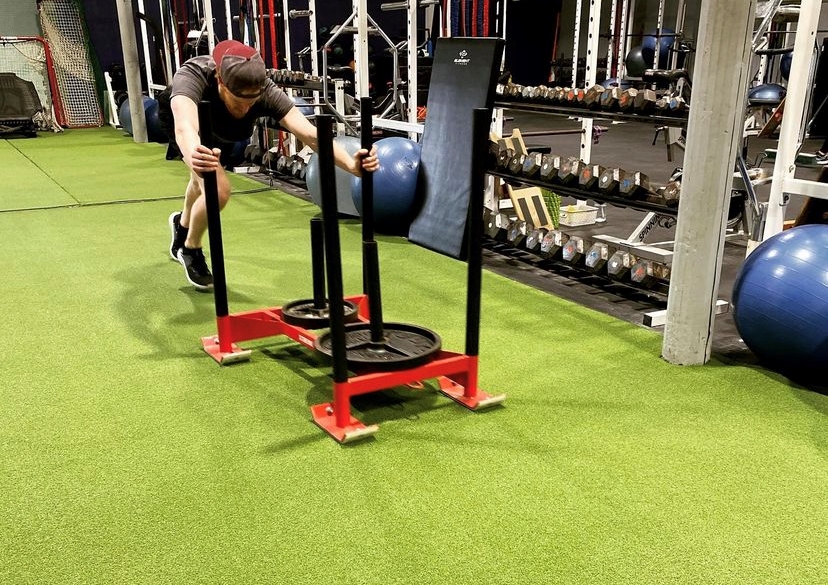
Overload. Adapt. Perform. Repeat.
Off-ice training that focuses on overloading the entire athlete will help enhance balance, athletic movement skills (speed-agility-quickness and reaction skills), strength and power production, mobility, stability and resilience to injury. The right exercises with the right coaching can take off-ice gains and see them expressed as improved on-ice performance.
Movement efficiency, reactivity, nervous system firing and skill execution under fatigue are often what separate the top players from the rest. Injuries often occur during high speed braking and when exploding out of a stop-and-start. Deceleration drills, agility, change of direction skills and plyometrics, with ongoing coaching and feedback for improved mechanics, can help prepare players for in-game demands and turn an injury risk into a strength. As players learn these athletic movement skills they will become more evasive, more confident and more durable.
Upper body strength is the biggest loser over the course of a season. Since skating is leg dominant, weight room time can shift more of a focus to upper body lifts and core strength and conditioning. Athletic, multi-joint lifts are stabilized by the core and initiated and fed by the legs so they are the most efficient for continual in-season development. Two to three short lifts per week with moderate to heavy weights are needed to maintain and improve upper body strength and mass.
Hip and shoulder mobility, core stability and overall mobility and flexibility are key in-season elements to injury prevention and performance. Uncovering weak links with each athlete and knowing which areas require the most attention, can help keep the focus of in-season programming as personal and efficient for each individual athlete in order to minimize wasted time and energy.
A properly designed seasonal program (post-season, off-season, in-season…) will carry the momentum of each training cycle into the next and allow the athlete to keep climbing higher, moving faster and performing better. Integrating stability, mobility, athletic movement, strength, power and conditioning into each training session can ensure that each player stays mentally sharp, physically prepared and physiologically capable of performing their best, when their best is needed.

